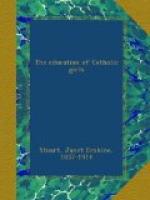The women who have been really great, whom we could not spare out of their place in history, have not been the student women or the remarkably learned. The greatest women have taken their place in the life of the world, not in its libraries; their strength has been in their character, their mission civilization in its widest and loftiest sense. They have ruled not with the “Divine right of kings,” but with the Divine right of queens, which is quite a different title, undisputed and secure to them, if they do not abdicate it of themselves or drag it into the field of controversy to be matched and measured against the Divine or human rights of kings. “The heaven of heavens is the Lord’s, but the earth He has given to the children of men,” and to woman He seems to have assigned the borderland between the two, to fit the one for the other and weld the links. Hers are the first steps in training the souls of children, the nurseries of the kingdom of heaven (the mothers of saints would fill a portrait gallery of their own); hers the special missions of peace and reconciliation and encouragement, the hidden germs of such great enterprises as the Propagation of the Faith, and the trust of such great devotions as that of the Blessed Sacrament and the Sacred Heart to be brought within the reach of the faithful. The names of Matilda of Tuscany, of St. Catherine of Siena, of Blessed Joan of Arc, of Isabella the Catholic, of St. Theresa are representative, amongst others, of women who have fulfilled public missions for the service of the Church, and of Christian people, and for the realization of religious ideals: true queens of the borderland between both worlds. Others have reigned in their own spheres, in families or solitudes, or cloistered enclosures—as the two Saints Elizabeth, Paula and Eustochium and all their group of friends, the great Abbesses Hildegarde, Hilda, Gertrude and others, and the chosen line of foundresses of religious orders—these too have ruled the borderland, and their influence, direct or indirect, has all been in the same direction, for pacification and not for strife, for high aspiration and heavenly-mindedness, for faith and hope and love and self-devotion, and all those things for want of which the world is sick to death.
But the kingdom of woman is on that borderland, and if she comes down to earth to claim its lowland provinces she exposes herself to lose both worlds, not securing real freedom or permanent equality in one, and losing hold of some of the highest prerogatives of the other. These may seem to be cloudy and visionary views, and this does not in any sense pretend to be a controversial defence of them, but only a suggestion that both history and present experience have something to say on this side of the question, a suggestion also that there are two spheres of influence, requiring different qualities for their perfect use, as there are two forces in a planetary system. If these forces attempted to work on one line the result would be




